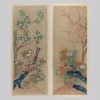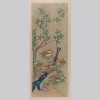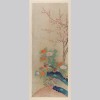본문
자연의 아름다움과 길상 의미를 함께 담은 조선시대 화조도(花鳥圖)입니다.
첫 번째 폭에는 매화와 모란 사이에 공작 한 쌍이 묘사되었습니다. 모란과 공작은 ‘부귀공명(富貴功名)’을 상징합니다. 이는 중국 길상화의 영향을 받아 조선 후기 궁중화나 민화에 등장한 도상입니다. 매화는 고결함을 뜻해 문인적 분위기를 더합니다.
두 번째 폭에는 하얀 꽃나무 아래 푸른 꼬리의 꿩 한 쌍이 묘사되었습니다. 꿩은 부부 화합과 자손 번창을 상징합니다. 함께 등장한 모란은 풍요와 번영을 상징하며 조화로운 삶에 대한 염원을 담고 있습니다.
이 화조도는 자연 속에 인간의 바람과 도덕적 미덕을 상징화하였습니다. 또한 조선 회화의 섬세한 운필과 상징 미학이 잘 드러납니다.
━━━━━
这是一幅融合自然之美与吉祥寓意的朝鲜时代花鸟图。
第一幅描绘的是梅花与牡丹之间,一对孔雀悠然相对。牡丹与孔雀在中国传统吉祥图案中象征“富贵功名”,并在朝鲜后期的宫廷绘画与民画中亦被广泛借用。同时,梅花象征高洁,增添了文人雅趣的氛围。
第二幅描绘的是洁白花木下,一对长尾翠雉并肩而立。雉鸟寓意夫妻和睦、子孙昌盛,与之相伴的牡丹象征富足与繁荣,表达了对和谐美好生活的愿望。
整幅花鸟图通过自然意象寓意人间的愿望与道德美德,充分展现了朝鲜绘画中细腻的笔法与象征美学。
━━━━━
This hwajodo (花鳥圖, painting of birds and flowers) from the Joseon Dynasty combines the beauty of nature with auspicious symbolism.
The first panel shows a pair of peacocks among plum blossoms and peonies. Peonies and peacocks symbolize wealth and honor, a motif influenced by Chinese auspicious paintings that appeared in royal and folk art of the late Joseon period. Plum blossoms, associated with purity and integrity, enhance the literati aesthetic.
The second panel features a pair of pheasants with blue tails under a white-flowered tree. Pheasants represent marital harmony and fertility, while the accompanying peonies symbolize abundance and prosperity, reflecting a wish for a harmonious life.
This hwajodo transforms human aspirations and moral virtues into symbolic imagery, demonstrating the refined brushwork and symbolic aesthetics of Joseon painting.



